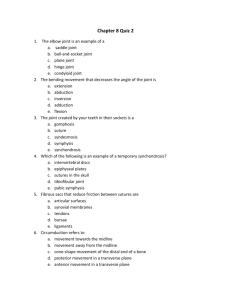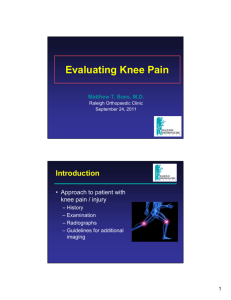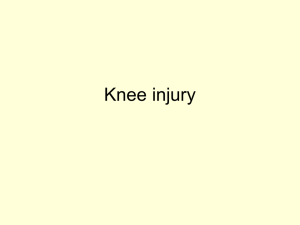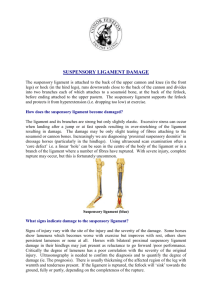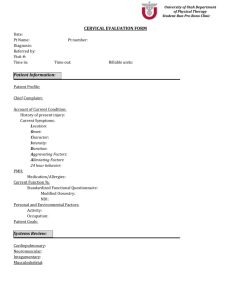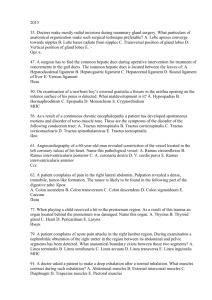Precautionary Ligament Testing
advertisement
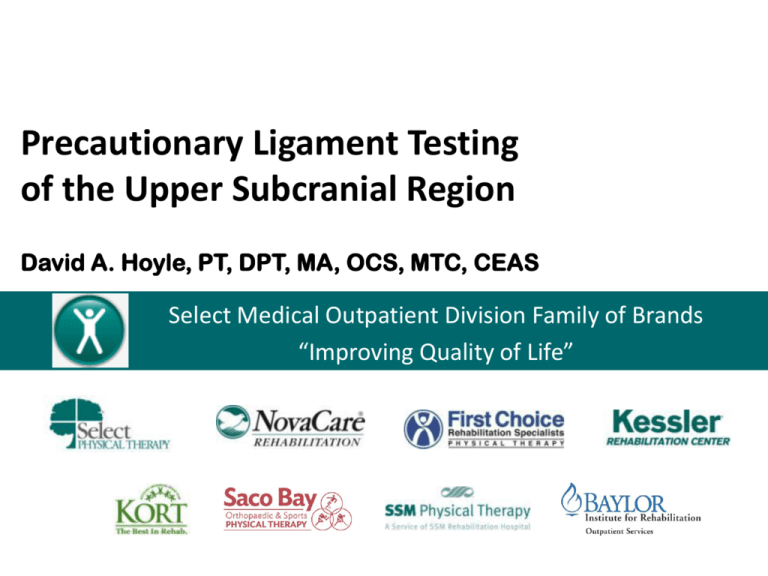
Precautionary Ligament Testing of the Upper Subcranial Region David A. Hoyle, PT, DPT, MA, OCS, MTC, CEAS Select Medical Outpatient Division Family of Brands “Improving Quality of Life” Objectives Understand the complexity of the joint integrity of the craniocervical junction. Be able to perform tests to assess the integrity of the: Alar ligaments Transverse Ligament 2 | Precautionary Ligament Testing- Hoyle Serious Injury Due to Neck Pain NATA includes Cervical Spine Injuries as one of the 10 covered conditions in its position statement on the prevention of sudden death in athletes.1 Physical Therapists often work with individuals with neck pain and these are frequently from a traumatic nature. 2 Athletic Trainers and Physical Therapists should be skilled in making assessments of ligamentous stability when making decisions about return to play and treatment advise. 3 | Precautionary Ligament Testing- Hoyle Incidence According to a recent report of the reasons for ED visits by teenage athletes, SCI accounted for < 1% of all visits.3 4 | Precautionary Ligament Testing- Hoyle Severity Recognition1 During initial assessment, the presence of any of the following, alone or in combination, requires the initiation of the spine injury management protocol: unconsciousness or altered level of consciousness, bilateral neurologic findings or complaints, significant midline spine pain with or without palpation, or obvious spinal column deformity. • Evidence Category: A1 5 | Precautionary Ligament Testing- Hoyle Athletic Case Sample Am J Orthop (Belle Mead NJ). 2014 Jun;43(6):272-4. Delayed presentation of a cervical spine fracture dislocation with posterior ligamentous disruption in a gymnast. Momaya A, Rozzelle C, Davis K, Estes R1. Abstract Cervical spine injuries are uncommon but potentially devastating athletic injuries. We report a case of a girl gymnast who presented with a cervical spine fracture dislocation with posterior ligamentous disruption several days after injury. To our knowledge, this type of presentation with such severity of injury in a gymnast has not been reported in the literature. The patient was performing a double front tuck flip and sustained a hyperflexion, axial-loading injury. She experienced mild transient numbness in her bilateral upper and lower extremities lasting for about 5 minutes, after which it resolved. The patient was neurologically intact during her clinic visit, but she endorsed significant midline cervical tenderness. Plain radiographs and computed tomography imaging of the cervical spine revealed a C2-C3 fracture dislocation. She underwent posterior open reduction followed by C2-C3 facet arthrodesis and internal fixation. This case highlights the importance of very careful evaluations of neck injuries and the maintenance of high suspicion for significant underlying pathology. PMID: 24945477 [PubMed - in process] 6 | Precautionary Ligament Testing- Hoyle Anatomy Review Upper Craniocervical junction Occuput with Foramen Magnum C1/Atlas C2/Axis Approx 80 deg of transv plane motion. 40 deg each direction prin at AA Approx 23 deg of total sagittal plane motion. 13 degrees at OA 10 degrees at AA Approx 16 deg of frontal plane motion 8 each direction at OA 7 | Precautionary Ligament Testing- Hoyle Anatomy Review Alar Ligaments Alar lig limit rotation Left alar checks right rotation and left sidebending. Right alar checks left rotation and right sidebending. Also tightnes in a subcranial flexed position. 8 | Precautionary Ligament Testing- Hoyle Anatomy Review Cruciform Ligament Superior Longitudinal Band Inferior Longitudinal Band Transverse Band Transverse lig. instability Limits anterior glide of axis on atlas which occurs with subcranial flexion In flexion distance from ant arch to dens < 2-3mm (child 3-4). 9 | Precautionary Ligament Testing- Hoyle Transverse Ligament Instability Clinical PresentationHistory of flexion injury with neck pain. Diffuse motor loss occurs with pyramidal tract injury. Radiographic findings of increased atlantodental interval > 3mm Wheeless’ Textbook of Orthopeadics 10 | Precautionary Ligament Testing- Hoyle Anatomy Review Apical Ligament Functional importance limited. A cranial continuation of the notochord. Between the foramen magnum and the alars dorsal to the atlantooccipital membrane and ventral to the superior band of the cruciform 11 | Precautionary Ligament Testing- Hoyle Anatomy Review- Tectorial Membrane Tectorial membrane a continuation of the posterior long. Lig. Becomes taught with subcranial nodding limiting AA flexion. Also becomes taught with subcranial backward bending limiting AA extension. 12 | Precautionary Ligament Testing- Hoyle Den’s or Peg Fracture . Literature on Detecting Instability Upper Cervical Ligament Testing in a Patient with Os Odontoideum Presenting with Headaches- Minkin Upper Cervical Ligament Disruption in a Patient with Persistent Whiplash Associated Disorder- Elliot Clinical Assessment Techniques for Detecting Ligament and Membrane Injuries in the Upper Cervical Spine Region- A Comparison with MRI Results- Kaale 14 Precautionary Ligament Testing- Hoyle 14 15 | Precautionary Ligament Testing- Hoyle Alar Ligament Test Description Patient is supine and the therapist grips and stabilizes the spinous process of the axis. The head and atlas are then side bent around the coronal axis of the atlantoaxial joint. Ipsilateral rotation of the axis is prevented by the stabilization of the axis. The end feel and the amount of motion are assessed. If the alar ligament is intact, little to no side bending can occur and the end feel should be capsular. The test is then repeated with rotation of the head and atlas on the axis and the end feel is assessed Result No excessive motion wasnoted and the end feel was capsular 18 | Precautionary Ligament Testing- Hoyle Alar-odontoid Ligament Integrity Test Test is done supine in slight flexion with one finger on either side of spinous process of C2 With SC lateral flexion, immediate movement into contralateral finger. With SC rotation, immediate movement into ipsilateral finger. 19 | Precautionary Ligament Testing- Hoyle Sharp-Purser Test Description The palm of one hand is placed on the patient’s forehead and the spinous process of the axis is then gently fixed by a pinch grip of the thumb and fingertip pads of the other hand. The head and neck are then gently flexed. Through palmar pressure on the forehead, the occiput and atlas are translated posteriorly. The unique feature of this test is that the stress component is intended to relieve the symptoms rather than aggravate them. It has also been reported that a clunk may be noted as the atlas reduces on the axis. Results Relieved lower extremity paresthesias. No excessive motion was noted and no sense of sliding or “clunking” was noted 20 | Precautionary Ligament Testing- Hoyle Transverse Ligament Test Description Patient supine with the head supported by a pillow in the neutral position. The therapist supports the occiput in the palms of the hands and the third, fourth, and fifth fingers while the 2 index fingers are placed in the space between the occiput and the C2 spinous process, thus overlying the neural arch of the atlas. The head and C1 are then lifted (sheared) anteriorly together, while the head is maintained in its neutral position and gravity fixes the rest of the neck. The patient is instructed to report any symptoms other than local pain and soreness. The sensation of a lump in the throat or the presence of cardinal signs or symptoms indicates a positive test. Result Positive for bilateral lower extremity paresthesias 21 | Precautionary Ligament Testing- Hoyle References 1. 2. 3. 4. 5. 6. 7. Casa DJ1, Guskiewicz KM, Anderson SA, Courson RW, Heck JF, Jimenez CC, McDermott BP, Miller MG, Stearns RL, Swartz EE, Walsh KM. National athletic trainers' association position statement: preventing sudden death in sports. J Athl Train. 2012 Jan-Feb;47(1):96-118. Childs JD, Cleland JA, Elliott JM, Teyhen DS, Wainner RS, Whitman JM, Sopky BJ, Godges JJ, Flynn TW; American Physical Therapy Association. Neck pain: Clinical practice guidelines linked to the International Classification of Functioning, Disability, and Health from the Orthopedic Section of the American Physical Therapy Association. J Orthop Sports Phys Ther. 2008 Sep;38(9):A1-A34. Nalliah RP, Anderson IM, Lee MK, Rampa S, Allareddy V, Allareddy V. Epidemiology of Hospital-Based Emergency Department Visits Due to Sports Injuries. Pediatr Emerg Care. 2014 Jul 24. [Epub ahead of print] Momaya A, Rozzelle C, Davis K, Estes R. Delayed presentation of a cervical spine fracture dislocation with posterior ligamentous disruption in a gymnast. Am J Orthop (Belle Mead NJ). 2014 Jun;43(6):272-4. Mintken PE1, Metrick L, Flynn TW. Upper cervical ligament testing in a patient with os odontoideum presenting with headaches. J Orthop Sports Phys Ther. 2008 Aug;38(8):465-75. Elliott JM, Cherry J. Upper cervical ligamentous disruption in a patient with persistent whiplash associated disorders. J Orthop Sports Phys Ther. 2008 Jun;38(6):377. Kaale BR, Krakenes J, Albrektsen G, Wester K. Clinical assessment techniques for detecting ligament and membrane injuries in the upper cervical spine region--a comparison with MRI results. Man Ther. 2008 Oct;13(5):397-403. 22 | Precautionary Ligament Testing- Hoyle

